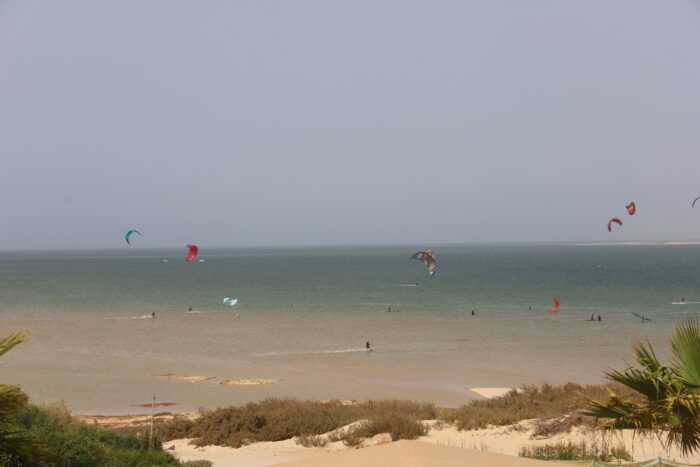« No negligence, no delays, no mismanagement will be tolerated in such a crucial issue as water. » For his 25th year of reign, Mohammed VI has reiterated his commitment to accelerating the projects scheduled under the water policy to pull the country out of a prolonged water crisis. At the forefront are the seawater desalination plants that are expected to ensure, by 2030, the annual mobilization of more than 1.7 billion cubic meters.
This goal will enable the country, in six years, to meet more than half of its drinking water needs through these plants, irrigate significant agricultural areas, and thus strengthen its food security, following a series of six years of drought that has severely impacted the agricultural sector.
Electricity to produce water
To produce this water, the future desalination plants must be « supplied with clean energy, » the sovereign emphasized in his speech on July 29 in Tétouan. This is why it is crucial to « accelerate the implementation of the electrical interconnection project aimed at transporting renewable energy from the southern provinces to the Center and North, » he insisted. It is a very ambitious project, yet it is experiencing delays in its initial phases.
Led by the National Office of Electricity and Potable Water (ONEE), this project aims to deploy a high-voltage power line between the south and north of the country, and was first unveiled in a call for expressions of interest (EOI) made public on October 31, 2023. Stretching approximately 1400 km, this electric highway is expected to supply 3 GW of electricity to Casablanca from green energy produced in Dakhla. According to specialists, this power is equivalent to the production of 7.5 million photovoltaic solar panels or 930 large-scale wind turbines.

Thus, in the south, the connection point will be located in Ouled Lekraa, about 60 km north of Dakhla. This will be linked to ONEE’s power plant in Mediouna, approximately 15 km south of Casablanca. Along the route of this electric highway, a series of converter stations will need to be installed in several municipalities, including Laâyoune, Tan-Tan, Agadir, and Marrakech, to connect the two points of entry and exit of the electricity while limiting energy losses to less than 5%.
Yet another delay
For the financial setup, ONEE has opted for a PPP (public-private partnership). The successful bidder will be responsible for the development, design, financing, construction, operation, and maintenance of the project over a 30-year period. According to ONEE’s initial timeline, work on this project was scheduled to begin in January 2025, with the designation of the future contractor expected in 2024. However, the deadline for submitting bids has been postponed six times. Initially set for January, it has been delayed to March 21, then May 16, then June 27, and finally to August 28. ONEE has not provided any explanation for these delays.
Experts in the sector still hope that the King’s new call will finally advance this crucial project for the country’s future. The delays faced are merely a symptom of a deeper problem with the governance of the renewable energy sector, which is characterized by « divergence, opacity, and discouragement of private initiative, » according to sector stakeholders interviewed by TelQuel last March. The primary issue raised is that of vision. Since 2009, no comprehensive, updated vision that garners the support of various stakeholders has been defined. While partial strategies, action plans, and roadmaps have been published here and there, they have not established overall coherence.
The tree that hides the forest
The sector also suffers from a multitude of actors with divergent responsibilities and priorities. This entanglement of responsibilities was indeed highlighted in the New Development Model (NMD). The diversity of actors « creates an overlap of roles and responsibilities, huge value losses impacting consumer prices and the financial stability of major players, » noted the team led by Chakib Benmoussa in the NMD, presented in 2021 to Mohammed VI.
Three years later, this observation remains unchanged. Six ministers manage the sector: Leila Benali, Minister of Energy for public policy; Abdelouafi Laftit, Minister of the Interior for distribution; Nadia Fettah and Fouzi Lekjaâ for price competitiveness and financial aspects.
In addition to this lineup, Ryad Mezzour, Minister of Industry, is responsible for industrial strategy, and Nizar Baraka, Minister of Equipment and Water, oversees energy infrastructure. Not to mention other public officials such as the directors of OHNYM (Amina Benkhadra), ANRE (Abdellatif Berdach), MASEN (Tarik Moufaddal, appointed in June 2024), as well as the central operator in this sector, ONEE, which has been led for two months by Tarik Hammane, replacing Abderrahim El Hafidi, who had been at the head of the Office for six years.
In the reports of the Economic, Social, and Environmental Council (CESE), as well as in the NMD, Ahmed Reda Chami and Chakib Benmoussa recommend limiting ONEE to the role of transporter and manager of the electrical grid. This transformation involves separating the water and electricity activities of the Office—activities that have never benefited from the desired synergy since the ONE-ONEP merger—as well as transferring ONEE’s renewable assets to MASEN, according to CESE and NMD. This reform has been stalled for a long time, but the signal from the highest level of the state, with the appointment of the new Director General of the Office and the call to accelerate the electric highway project, could well bring it back on track.
Written by Safae Hadri, edited in English by Eric Nielson



